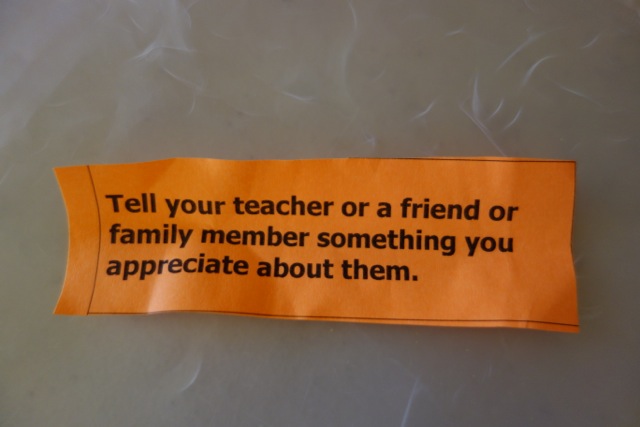 Parents want children to fit in, to be happy, and to be "good". And research shows that these desires of parents are not only reasonable and complementary, they're reciprocal.
Parents want children to fit in, to be happy, and to be "good". And research shows that these desires of parents are not only reasonable and complementary, they're reciprocal.
Really?
Yes. Students who regularly perform kind acts can expect to be more accepted by peers and to increase their general sense of well-being[1]. This is important because increased social acceptance is also related to positive social and academic outcomes, and it reduces the incidence of bullying.
At Highlands Elementary in North Vancouver, parents decided that rather than spend the year on fundraising goals and activities, they would actively create opportunities to "grow kindness" throughout the school. The focus was on encouraging regular and purposeful, prosocial activities for students and their families.
On special days like World Kindness Day, Pink Shirt Day, and Pay It Forward Day, student volunteers cut out brightly coloured "fortunes" of kindness and put them in buckets. Standing outside the school with bright balloons, student kindness ambassadors invited arriving staff, parents and students to draw a fortune at the beginning of the school day. The fortunes said things like: "Say something nice to someone", "Thank a teacher, friend or family member for something nice they have done" or "Help someone at school."

Any leftover fortunes were placed in classrooms for teachers and students to use as they chose throughout the school day. Some classes took on a "fortune" as a classroom wide initiative and once a month, the class would engage in a random act of kindness, like "Write a kind note and give it to someone", or "Give a friend or family member a hug." or "Tell someone they are special." In other classrooms, kids or staff would help themselves to a fortune when they felt like it and quietly do what the fortune invited them to, like "Give someone a little gift that doesn't cost anything."
The parent group helped create a place where being at school is about fostering compassion by being kind. Small acts of kindness go a long way to creating a place where "kindness" is just how it's done. And for the kids, they realized that demonstrating their care and thoughtfulness through their actions is not a one-day sort of thing, and that it feels good!
Here’s how to organize your own Kindness Fortune Event:
Materials and People Required
-
Brightly coloured 8.5 x 11 " photocopy paper
-
Computer-generated sheets of kindness fortunes (set up like labels)
-
Buckets to hold the fortunes (for a school of 400, plan on 8-10 buckets)
-
Brightly coloured balloons to tie to the buckets to attract attention
-
One or two people to lead the event
-
Student volunteers (old enough to help younger students read) to hand out fortunes
-
Optional advertising for your "special day"
-
Several pairs of scissors (kids can cut out fortunes at a meeting) or access to the school cutter to snip many fortunes at once
Pre-Planning
-
With school administration support (implicit or explicit), assemble parent volunteers and identify areas of interest
-
Invite student involvement
-
Meet with students to plan and activate their thinking about what kindness, compassion and empathy are by inviting them to explore ideas through video, discussion and their own research
-
Generate kindness fortune ideas
-
Make sure to include all staff (this is where the school administrator could be very helpful)
On Your "Kindness Fortune" Day
-
Check the weather, and remind kids to dress so they will be comfortable
-
Ask volunteers to arrive early enough to organize the balloons
-
Have at least two students per bucket so that one can be helping the younger students if needed
-
Position volunteers to greet people as they arrive at school (go through the school to include teachers)
Follow-Up Activities
-
In classrooms, invite kids to talk about what they did for their random acts, how they felt about it, and what they noticed about how people responded to them?
-
Place one bucket of leftover fortunes in each class and invite teachers and students to continue to engage in random acts of kindness.
-
Debrief the event with the student and parent volunteers.
-
Ask classes to write up some of their best experiences and share them with the school community in the parent newsletter, school newsletter, front hall school display, or school-wide assembly.
-
Read books[2] during story time about kindness (primary), and choose kindness-related books or literature circles in higher grades to further integrate kindness conversations.
-
Add a Pay-it-Forward variation. Those who receive a kindness fortune not only engage in a random act of kindness, but also invite the person they did something kind for to do the same with another person.
In a study of urban 9-11 year olds, those that performed three acts of kindness per week (compared to a control group) showed improvements both in well-being and in peer acceptance (popularity).
Check out the downloadable Heart-Mind Online booklists for recommendations.